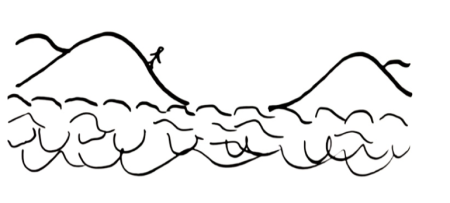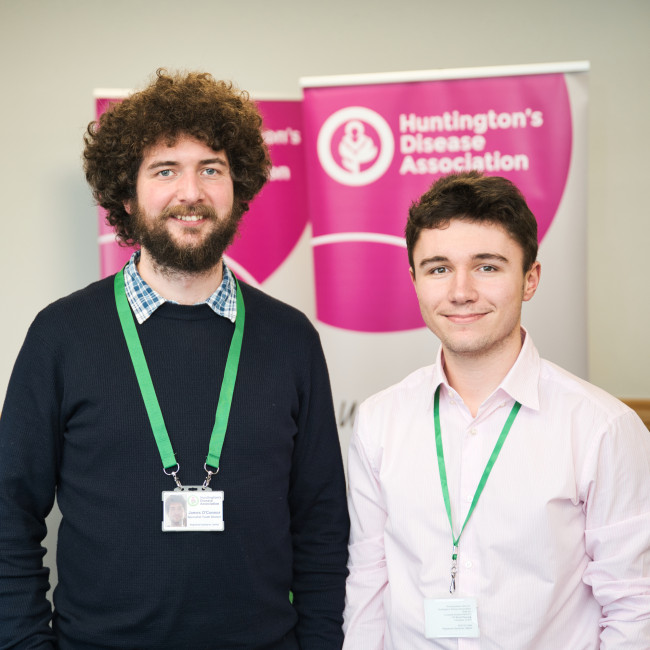Simon, 59, was diagnosed with Huntington's in 2004 and began showing symptoms in 2010.
Before retiring eleven years ago, he worked as an accident and emergency nurse and led a liaison psychiatry nursing team in the latter part of his career. Simon is married with two children and has just welcomed the birth of his first grandchild. He hopes that by sharing his story he can encourage others to take part in physical activity which is very close to his heart.
Physical activity background
Inspired by his brother’s maps, Simon took up the sport of orienteering in High School. Here he also explored running more broadly and represented Cheshire schools for cross country. However, Simon didn’t find this activity challenging or exciting enough.
“Cross country bored me a little where it was fairly open countryside and you could see where you're going. I prefer to use my mind and map reading skills.”
Therefore, Simon's passion for orienteering and love of challenges led him to represent Britain at a junior level, and this eventually progressed into longer races such as fell running and mountain marathons.
“The sorts of things where you would carry your tent and sleep overnight – crazy, crazy stuff.”
Running took a back seat for a few years whilst he trained as a nurse and raised his young family, but Simon always retained his love of discovery. He returned to orienteering at weekends in a less competitive way by shifting his focus to personal goals and fitness. The mental aspect of map reading combined with the physical exercise of hard running through the beautiful countryside was the ideal way to switch off from life’s stresses.
Huntington's disease
In retrospect, Simon’s first symptom of Huntington’s disease affected his ability to run as he was particularly struggling with something he had always done. First putting it down to getting older, Simon soon realised he couldn’t compete against people his own age.
“It came quite quickly, the sort of tiredness... afterwards it would take me a couple of days to recover. I got these very strange and sudden cramps in my legs that would make weird shapes.”
Simon adjusted by completing shorter courses and running against people older than him until he gradually became too tired to do this. At work, he was unable to complete a full week without going home to rest. However, Simon could still walk, and he adapted his physical activity to strolling along the woodland trails he once ran. This even allowed a new interest to flourish – birdwatching.
Physical activity now
Now, Simon has a routine of various things to keep fit and well. He has deliberately split his physical activity between exercise for his body and exercise for his mind. Simon’s routine starts off in the morning when he goes on a walk for about thirty minutes to an hour.
“It’s usually a little way through streets and then into the local park, woods, or the countryside nearby. Sometimes I'll do different things like I'll go into town and do some shopping or chores, or I'll go to Wakefield for their art gallery.”
Part of Simon’s walk is deliberately swift with a focus on purposeful strides. The other part is more relaxed with Simon gently appreciating nature and wildlife around him, stopping if anything catches his eye. Woodpeckers, flowers, foxes, sparrows, deer, and golden eagles are all things Simon has discovered on his strolls and gazing at the sky. He doesn’t have a must-see list of birds or wildlife but allows curiosity to guide him to see what's out there.
“I go very regularly birdwatching with an ex-colleague and one time we'd gone to a bird reserve. We've been sat in the hide for about half an hour, and I said,
“Paul, have you seen any birds yet?”
He said, “No”.
I said, “Neither have I!”
But it didn't matter because it was nice. It was a nice day, it was a nice view, and we were having a nice chat. It really didn't matter that we haven't seen any birds, and that was quite funny.”
He still enjoys looking at maps and, when visiting his son in Berlin, Simon likes to navigate the U-Bahn and trams to find his way around the city. Most of the time though, he stays local and enjoys the solitude the woods provide, except for the last few weeks when he has been pushing a pram. In the evenings, Simon works on his targeted physical therapy which his family calls ‘rolling back on the floor'.
Motivation and goal setting
Motivation is a difficult thing for Simon, but he has found useful tools to overcome the apathy he faces. Encouraged by his wife who was tracking 10,000 steps at work, Simon decided to join in with his own step counter as a way of motivating himself to do a daily walk.
“My kids then got me into one of these watches that measure various activities, so I achieve all those goals almost every day that I've got my watch on. The issues I’ve faced with physical activity is measuring what I can do within my limits, but then also testing myself a bit further within that.”
Adjustable to his needs, he balances his goals by pushing himself enough to stretch his abilities without becoming too tired. The watch also allows for a holistic overview of exercise, and this helps Simon build a daily physical activity routine. “Not first thing because I'm lousy at getting up, but I always go out in the morning and do my exercise to get it done for the day because otherwise I'll procrastinate”.
His family also aids his motivation, reminding and encouraging him to do physical activities such as his ‘rolling’ and daily walking. If he doesn’t do his physical activities, Simon notices that his symptoms can quickly take hold which further spurs him on.
“If I don’t work on the very targeted things like my back and feet muscle spasms, then those things can become quite disabling. The daily walk does help.”
Advice
“Physical activity is getting over the procrastination and the apathy by finding something that's interesting to you. You know, you could just give in to the progression of symptoms and think ‘Oh well, I'm ill and this is how it's going to be’, or you can try and do something about it. You can always improve. Just because you've got Huntington's disease doesn't mean that you can't improve your fitness within that parameter, you know? I was tired and I couldn't run, but I could still improve how fast I walked. But it's having the motivation to do it every day. The big message is that physical activity keeps me well and makes such a difference to my health both mentally and physically.”
Simon’s physical activity representation
Often words are not enough to convey what we are feeling, and sometimes it’s easier to describe an experience through a visual metaphor. This is something that allows invisible emotions to become visible by comparing them to something that everyone can relate to. Here, Simon created his feelings towards physical activity in drawing by using the 'DrawingOut Method'.


My feelings towards physical activity would be represented by cloud inversion. You get it in the Peak District near here and it's usually early in the morning. The valleys are filled with low-lying clouds so if you were standing at the bottom it would be a misty, gloomy, dull day.
But when you climb the hills, you see a view like the one you see out of an airplane during takeoff. As the plane pulls up, you break through the clouds and it’s suddenly bright. I don’t climb mountains anymore, but standing on the hilltop I see the most beautiful summer's day. You can see the tops of the clouds, the sun and the hills around sticking up out of the mist.
Sometimes when I’m walking, I feel like I’m running uphill and I get pain in my legs quite quickly. But because I used to be a runner, I recognise this pain and so I know it is okay. Whereas somebody who isn't used to it might think ‘I've got pain in my legs, I'd better stop’. I keep walking because I know that I’m going to get to the top of the hill eventually.
The cloud in the valley represents the symptoms - the foggy headaches, tiredness and stiffness. If you can motivate yourself to come out of the valley, you find yourself above the clouds and see it’s a pleasant day. But some days are harder than others. Going out and exercising... it's not always easy. Sometimes it's just cloudy and you don’t get above the clouds. Sometimes it's just a bad day, and that's okay.
"I always feel better for doing some exercise. Even when it's a lousy day and I come back feeling tired and grotty, it's better than doing nothing. This feeling of coming out of the clouds to a beautiful day... that’s how I feel about exercise really. It does something for me. You could very easily stay at home in the fog and miss a beautiful moment."


This interview was conducted by students from Cardiff University and led by Dr Una Jones. Thank you on behalf of the Huntington's Disease Association for working on these studies as part of a physical activity project.






